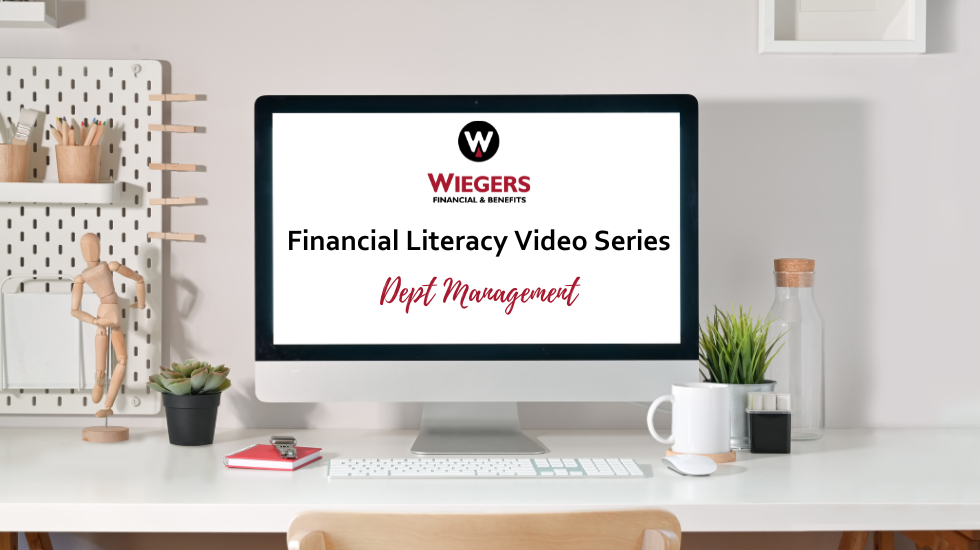The Financial Literacy Video series is your exclusive gateway to financial empowerment brought to you by Wiegers Financial & Benefits. In this series, we offer invaluable perspectives and tailored approaches to bring your financial goals to life. Whether you’re just beginning or seeking to refine your financial planning, we have the resources for all. Stay tuned as we explore essential financial topics in the coming posts, and let’s work together to unleash your financial potential. Your brighter financial future starts here. In our latest VLOG, Kim Chicoine, a trusted financial advisor will provide you with information about how you can effectively manage your dept.
Debt Management Defined
Debt management is a simple enough concept. It means getting your debt under control through planning and budgeting with the ultimate goal of eventually eliminating your debt. It’s not always easy – sometimes it’s incredibly challenging – but becoming debt-free is a reward worth working for.
Debt Management Steps
But how does one become debt free? There are several steps I recommend you take to help you get on that highly sought after path:
1. List Your Debts
-
- To effectively manage your debt, the first step is to gain a clear understanding of your financial obligations. Start by listing all your debts, including credit cards, student loans, mortgages, and any other outstanding loans. Record the amount owed, minimum payments, interest rates, and whether the rates are fixed or variable. This comprehensive list will serve as a foundation for debt management strategies.
- Determine how each debt was accumulated. Understanding the circumstances that led to your debt will help you identify common pitfalls to avoid in the future. By recognizing patterns and triggers, you can implement proactive measures to prevent further debt accumulation.
2. Create and Follow a Budget
-
- Effective budgeting is key to managing and ultimately eliminating debt. Start by prioritizing your needs over wants. This includes housing expenses, groceries (avoid eating out), transportation costs, and debt payments. By spending less than you earn and cutting out unnecessary expenses, you can free up funds for debt repayment or identify areas where you may be overspending.
3. Develop a Debt Repayment Strategy
-
- Once you have established a budget, it’s time to develop a strategy to tackle your debt. Begin by setting a timeframe for reducing or eliminating your debts, and make sure to write it down. Writing down your goals helps reinforce them in your mind and provides a sense of accountability. As Cliff Wiegers often says, “Think it, then ink it!”
- Decide which debt to pay off first. Two common methods are the snowball method and the avalanche method. The snowball method involves making minimum payments on all debts and directing extra payments towards the smallest loan first. Once that debt is cleared, move on to the next smallest debt. The avalanche method, on the other hand, focuses on paying off debts with the highest interest rates first while making minimum payments on all other debts. Whichever method you choose, maintaining consistent monthly payments even after one debt is paid off will expedite your debt repayment.
4. Consider Consolidating Your Loans
-
- If you find it challenging to pay down your debt, loan consolidation may be a viable option. Consolidating high-interest loans into a single loan with a lower interest rate can help streamline your payments and potentially save you money in the long run. However, it is important to research and compare different lenders before applying, as multiple loan applications within a short period can negatively impact your credit score.
5. Avoid Taking on More Debt
-
- One of the most critical steps in debt management is breaking the cycle of relying on debt. When you finance purchases instead of saving for them, you end up paying interest to the lender rather than earning interest on your savings. By making a conscious effort to save for future purchases, you take control of your financial well-being and avoid falling into a perpetual cycle of debt accumulation.
6. Know Where to Get Help
-
- If you’re finding it challenging to navigate your options or develop an effective debt management plan, don’t hesitate to seek professional help. Non-profit counselors or licensed insolvency trustees, such as those recommended by the Government of Canada, can guide you through the process, help you address your situation, and provide valuable advice on dealing with creditors.
Managing debt is a crucial part of achieving financial freedom. By assessing your debt, creating a budget, developing a repayment strategy, and considering consolidation options, you can take control of your financial situation. Remember, seeking professional assistance is always an option if you need additional support. With dedication and perseverance, you can pave your way to a debt-free future. Watch Kim below to learn more about how you can make the most of your financial freedom.
Kim Chicoine, CFP, B.Comm.
Financial Planner, Manulife Securities Investment Services Inc.
Insurance Representative, Wiegers Financial and Insurance Planning Services Ltd.
The opinions expressed are those of the author and may not necessarily reflect those of Manulife Securities Investment Services Inc.
Mutual funds are offered through Manulife Securities Investment Services Inc. Insurance products and services are offered through Wiegers Financial and Insurance Planning Services Ltd. Banking products and services are offered by referral arrangements through our related company Manulife Bank of Canada. Please confirm with your Advisor which company you are dealing with for each of your products and services.
